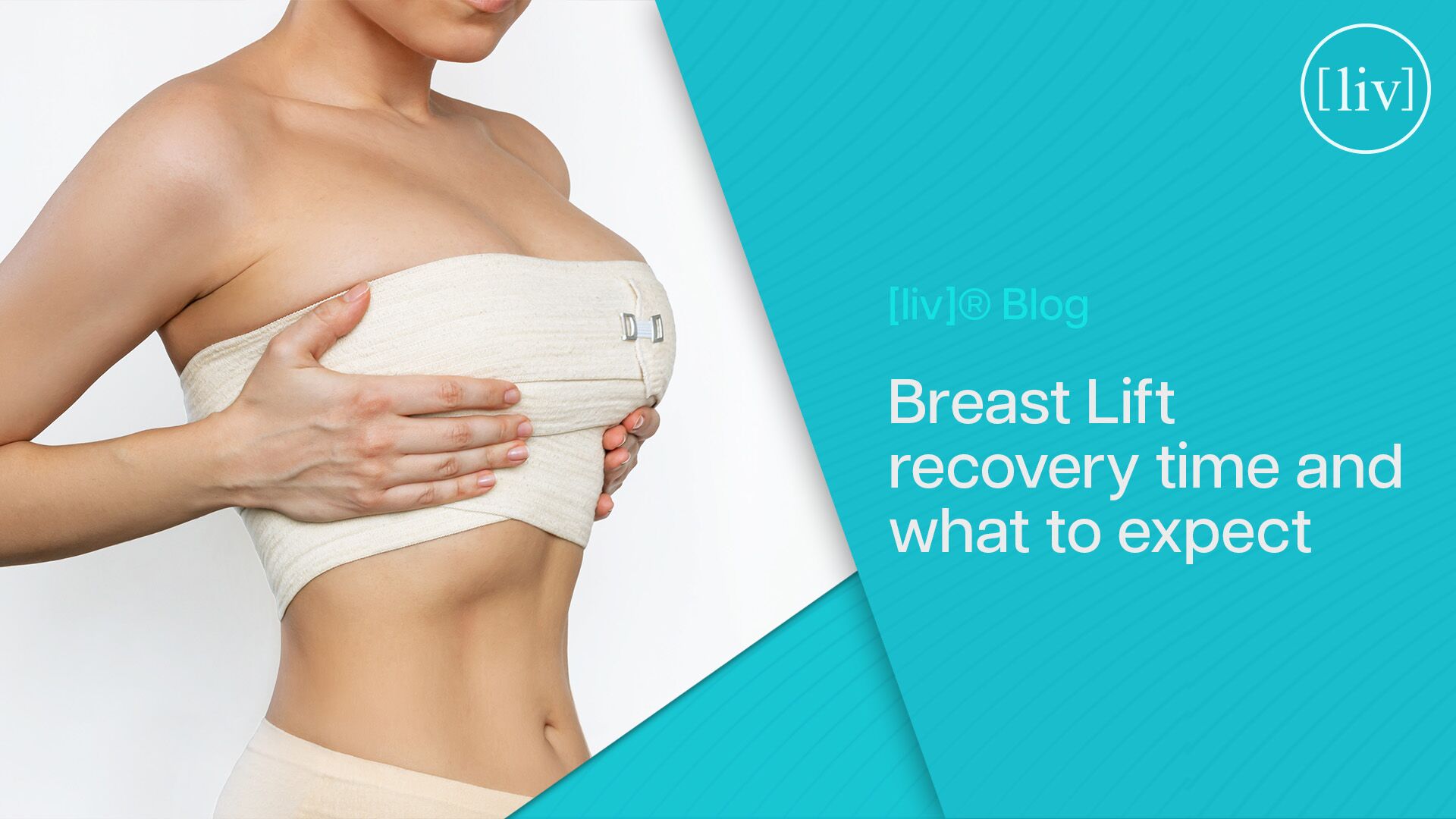Celebrate Mother's Day with Dr. Andrew Ress at [liv]
May 08, 2025
Shine Bright This Holiday Season: Unveil Your Best Self!
December 18, 2024

Discover the expected recovery time for breast lift surgery. Learn about post-operative care, healing process, and factors influencing recovery duration.
A comprehensive understanding of the recovery time for breast lift surgery is essential for those considering the procedure. Managing expectations and planning postoperative care during the recovery period is essential for ensuring a smooth and successful outcome, from managing expectations to planning postoperative care. In this introduction, we will discuss the factors influencing recovery time, post-surgical care tips, and insights into the healing process following a breast lift.
Breast lifts are surgical procedures designed to lift and reshape the breasts to give a firmer, more youthful appearance. Among those seeking to address sagging or drooping breasts due to factors such as pregnancy, breastfeeding, weight fluctuations, or aging, this procedure is popular.
After a breast lift, recovery time may vary depending on several factors, such as the individual's overall health, the extent of the procedure, and the individual's adherence to postoperative instructions. Although the experience of each individual may differ, there are some general guidelines to follow when estimating recovery time.
A breast lift patient will spend some time in the recovery room under observation before being discharged. During this time, the effects of anesthesia gradually wear off, and patients are monitored for any immediate complications that may arise.
It is common for the initial days following breast lift surgery to be the most challenging regarding discomfort and restricted movement. It is possible for patients to experience swelling, bruising, and mild to moderate pain or discomfort, which can be managed with prescribed pain medications and adequate rest. During this time, it is crucial to avoid strenuous activities, lifting heavy objects, or reaching above shoulder level.
A patient's swelling and bruising typically peak during the first week after surgery, before gradually subsiding. As discomfort diminishes, patients may begin taking over-the-counter pain relievers in place of prescription medications. To support the healing process and reduce swelling, it is imperative that compression garments or surgical bras continue to be worn as instructed by the surgeon.
As a result of the procedure, many patients begin to feel more comfortable and notice improvements in their breast appearance by the end of the second week or beginning of the third week. The swelling and bruising may still persist, but they will gradually diminish over time. When the patient is no longer exposed to strenuous physical exertion at work, they may gradually resume light activities. However, it is important to avoid activities that could strain the chest area or disrupt healing.
In most cases, patients experience significant improvement in mobility and comfort after one month. Although residual swelling may persist for several weeks or even months, the breasts gradually settle into their new position, and scars begin to fade in time. It is generally possible for patients to resume most of their normal activities, including exercise and lifting, after surgery, but follow the surgeon's instructions regarding the timing and intensity of physical activities.
It may take several months to fully manifest the final effects of a breast lift, although most swelling and bruising resolve within a few weeks to months of surgery. In order to monitor the healing process and address any concerns or complications that may arise, it is imperative for patients to attend follow-up appointments with their surgeon. Furthermore, maintaining a healthy lifestyle, including proper nutrition and skincare, can help patients recover optimally and be satisfied with the results of breast lift surgery for a long period of time.
While the duration of recovery from breast lift surgery varies from individual to individual, most individuals should see significant improvements within a few weeks of the procedure. Over a period of several months, the results will continue to be refined. Patients can enhance their recovery experience and enjoy the benefits of a rejuvenated breast appearance by following post-operative care instructions and attending follow-up appointments.
It is important to ensure optimal healing and minimize complications following surgery, whether elective or necessary. Following the guidance of your healthcare provider and following specific post-surgery instructions are essential steps in ensuring a smooth recovery process. These are some key post-surgery care tips to consider:
As a result of proper post-surgery care, optimal healing is promoted, complications are reduced, and the best possible outcomes are achieved. Following these post-surgery care tips and working closely with your healthcare team will allow you to navigate the recovery process with confidence and achieve a successful and smooth outcome.
For optimal results and a smooth recovery, it is essential to prepare thoroughly before undergoing a breast lift procedure. Here are some of the things to expect during the preparation phase:

You can maximize the outcome of your breast lift procedure and promote a successful recovery journey by diligently following these preparatory steps and working closely with your surgeon.
In breast lift surgery, or mastopexy, the breasts are elevated and reshaped to create a more youthful and appealing appearance. Although the procedure's general objectives remain the same, patient experiences and outcomes can vary depending on several factors. Understanding these variations is imperative for individuals seeking breast lifts.
The ability to communicate effectively between plastic surgeons and patients is crucial to managing expectations, resolving concerns, and achieving satisfactory results. In order to ensure a personalized treatment plan and realistic expectations, patients should openly discuss their goals, concerns, and medical histories with their surgeon.
You may notice immediate changes in the appearance of your breasts following a breast lift procedure. However, the changes will continue to evolve and settle over the course of the following months.
It is normal for your scars to appear red and slightly raised at first. However, they usually undergo a transformation within one to two years of the surgery, becoming softer and thinner. In addition, the scars resulting from a breast lift are often discreetly located and are easily concealable by bathing suits and bras.
After the procedure, you may also notice a small reduction in your bra size, even if you have not undergone a simultaneous breast reduction. This reduction is caused by the firmer and more rounded breasts you have after the procedure.
There is a need to recognize that the effects of a breast lift may not be permanent. As we age, our skin naturally loses some of its elasticity, resulting in some degree of sagging over time. Individuals with large or heavier breasts may experience this effect more significantly, however maintaining a healthy, stable weight can extend the longevity of your breast lift.
While immediate changes following a breast lift are evident, it is important to understand the evolution of results over time, including the transformation of scars and possible changes in breast size. As long as you maintain a steady weight and follow postoperative care guidelines, you will be able to maintain your breast lift results for a very long time and enjoy a rejuvenated appearance for many years to come.
After the operation, you will typically be discharged the following day. Following the procedure, you may experience bruising, twinges, and discomfort for several weeks. Although swelling may persist for several months, it may take up to a year for your breast shape to settle completely.
There is a very high likelihood that any changes to nipple sensitivity will be temporary in most cases. The majority of women report that nipple sensation returns within a few months following surgery.
Breast lifts are surgical procedures, and, as with any surgical procedure, there are risks and potential complications, including: An uneven appearance of the breasts (breast asymmetry), Blood clots or bleeding, It may be possible to experience changes in sensation, including numbness in the breast skin, nipples, or areolas.
A breast lift, also known as mastopexy, usually results in a decrease of approximately one cup in bra size. However, this reduction is not typically the result of a loss of volume. The procedure involves removing or repositioning excess skin and sagging breast tissue during which excess skin and sagging tissue are removed or repositioned.
Individuals considering this surgical procedure should be aware of the recovery time associated with this procedure. Various factors contribute to the variation in recovery duration, including individual healing capacity, surgical technique, and post-operative care. However, general guidelines should be considered when determining the recovery duration.
As a result of the surgery, patients typically see noticeable improvement in their breast appearance within the first few weeks, with continued refinement of results over several months. Postoperative instructions must be followed diligently by patients, including managing discomfort, avoiding strenuous activities, and attending follow-up appointments.
Patients will be able to enjoy the long-term benefits of rejuvenated breasts as a result of doing so, thereby optimizing their recovery experience.
May 08, 2025
December 18, 2024
Copyright © Liv Plastic Surgery 2026. All Rights Reserved

Consultations are complimentary in person or virtual.
We love our out of town patients!
